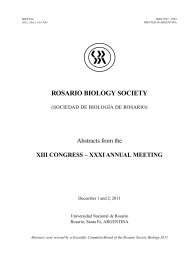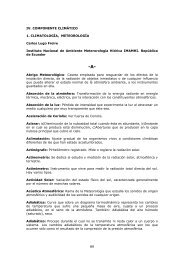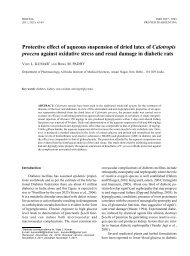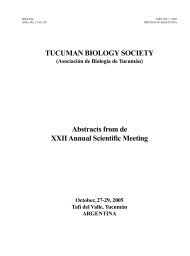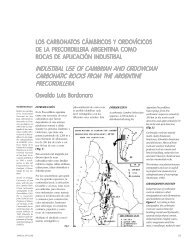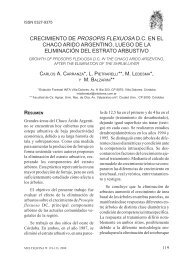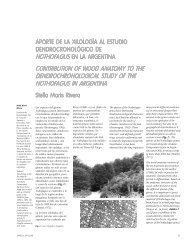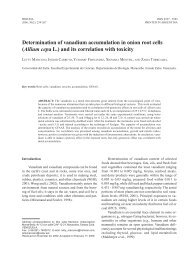Brief Note Cytochemical localization of acid phosphatase in ...
Brief Note Cytochemical localization of acid phosphatase in ...
Brief Note Cytochemical localization of acid phosphatase in ...
Create successful ePaper yourself
Turn your PDF publications into a flip-book with our unique Google optimized e-Paper software.
BIOCELL<br />
2006, 30(3): 491-496<br />
<strong>Brief</strong> <strong>Note</strong><br />
<strong>Cytochemical</strong> <strong>localization</strong> <strong>of</strong> <strong>acid</strong> <strong>phosphatase</strong> <strong>in</strong> Stigeoclonium<br />
tenue (Chaetophorales, Chlorophyceae)<br />
KARINA M. MICHETTI 1,2 , PATRICIA I. LEONARDI 1,3 AND EDUARDO J. CÁCERES 1,4<br />
1. Laboratorio de Ficología y Micología, Dpto. de Biología, Bioquímica y Farmacia, Universidad Nacional del Sur, Bahía<br />
Blanca, Argent<strong>in</strong>a.<br />
2. Fellow <strong>of</strong> Consejo Nacional de Investigaciones Científicas y Técnicas (CONICET).<br />
3. Researcher <strong>of</strong> Consejo Nacional de Investigaciones Científicas y Técnicas (CONICET).<br />
4. Researcher <strong>of</strong> Comisión de Investigaciones Científicas de la Prov<strong>in</strong>cia de Buenos Aires, Argent<strong>in</strong>a (CIC).<br />
Key words: Chaetophorales, <strong>acid</strong> <strong>phosphatase</strong>, Stigeoclonium tenue, ultrastructure<br />
Introduction<br />
ISSN 0327 - 9545<br />
PRINTED IN ARGENTINA<br />
ABSTRACT: Nonspecific <strong>acid</strong> <strong>phosphatase</strong>s are a group <strong>of</strong> enzymes whose activity <strong>in</strong>creases the availability<br />
<strong>of</strong> exogenous and endogenous orthophosphate either through extra- or <strong>in</strong>tracellular hydrolysis <strong>of</strong> phosphate<br />
compounds. Our study demonstrates the activity <strong>of</strong> <strong>acid</strong> <strong>phosphatase</strong>s <strong>in</strong> the filamentous freshwater<br />
alga Stigeoclonium tenue. These enzymes were detected follow<strong>in</strong>g a cerium-based method <strong>in</strong> which cerium<br />
was used as an orthophosphate-capture reagent. In thalli from S. tenue from the natural environment, <strong>acid</strong><br />
<strong>phosphatase</strong>s were found <strong>in</strong> the longitud<strong>in</strong>al cell wall, plasmalemma, and vacuole. In thalli from Bold’s Basal<br />
Medium culture, these enzymes were found ma<strong>in</strong>ly <strong>in</strong> the plasmalemma; they were scarce <strong>in</strong> the cell wall. In<br />
the thalli grown <strong>in</strong> phosphate-enriched culture medium, enzymes were found only <strong>in</strong> the plasmalemma. The<br />
low availability <strong>of</strong> orthophosphate <strong>in</strong> the medium seems to <strong>in</strong>duce the transport <strong>of</strong> these enzymes to the cell<br />
wall. Its abundance, on the contrary, seems to attenuate this response without affect<strong>in</strong>g the <strong>localization</strong> <strong>of</strong><br />
<strong>acid</strong> <strong>phosphatase</strong>s <strong>in</strong> the plasmalemma.<br />
Phosphorus (P) is one <strong>of</strong> the most important m<strong>in</strong>eral<br />
nutrients required by algae for growth and development<br />
(Lee et al., 1999). Orthophosphate anion (P i ) is<br />
preferentially assimilated by organisms such as algae<br />
Address correspondence to: Dra. Kar<strong>in</strong>a M. Michetti. Laboratorio<br />
de Ficología y Micología, Dpto. de Biología, Bioquímica y<br />
Farmacia, Universidad Nacional del Sur. San Juan 670, (8000)<br />
Bahía Blanca, ARGENTINA.<br />
E-mail: michetti@uns.edu.ar<br />
Received on February 13, 2006. Accepted on July 6, 2006.<br />
which obta<strong>in</strong> their m<strong>in</strong>eral nutrients directly from the<br />
environment (Moraes, 1991).<br />
Natural water conta<strong>in</strong>s different organic P compounds<br />
which degradation is low. Enzymatic hydrolysis<br />
is, therefore, the only mechanism by which biologically<br />
active orthophosphate is released from organic P<br />
(Gilbert et al., 1999; Wasaki et al., 1999).<br />
Acid <strong>phosphatase</strong>s (APases, orthophosphoric-monoester<br />
phosphohydrolases) are a group <strong>of</strong> enzymes that<br />
catalyze the hydrolysis <strong>of</strong> a wide spectrum <strong>of</strong> orthophosphate<br />
monoesters and anhydrides with an optimum<br />
pH rang<strong>in</strong>g between 5.0 and 6.0 to f<strong>in</strong>ally release phosphate<br />
ions (Duff et al., 1994; Gilbert et al., 1999; Ferreira
492<br />
et al., 2000). APases exhibit broad and overlapp<strong>in</strong>g substrate<br />
specificities (Gellatly et al., 1994). There are two<br />
different categories <strong>of</strong> plant APases that are differentiated<br />
from each other accord<strong>in</strong>g to their relative substrate<br />
selectivities. One <strong>of</strong> such categories <strong>in</strong>cludes specialized<br />
enzymes such as 3-P glycerate (3-Pga) <strong>phosphatase</strong><br />
and phosphoenolpiruvate (PEP) <strong>phosphatase</strong> which display<br />
a clear though non-absolute substrate specificity.<br />
The second category <strong>in</strong>cludes those truly nonspecific<br />
enzymes that show either low or no substrate specificity<br />
(Duff et al., 1994). These nonspecific enzymes are<br />
the focus <strong>of</strong> attention <strong>of</strong> the present research. APases<br />
are responsible for extra- and <strong>in</strong>tracellular phosphate<br />
cleavage and they are apparently ubiquitous <strong>in</strong> nature,<br />
occurr<strong>in</strong>g <strong>in</strong> many animal tissues, plants, and microorganisms<br />
(Törnqvist, 1989; Duff et al., 1994; González<br />
et al., 1994; Ferreira et al., 2000). Intracellular forms<br />
occur <strong>in</strong> all plant tissues <strong>in</strong> vacuolar as well as cytoplasmic<br />
locations (Gilbert et al., 1999; Turner and<br />
Plaxton, 2001). APases might be <strong>of</strong> relevance ma<strong>in</strong>ly <strong>in</strong><br />
habitats with low concentrations <strong>of</strong> <strong>in</strong>organic phosphorus<br />
as they may enable cells to hydrolyze extracellular<br />
phosphate esters, <strong>in</strong>creas<strong>in</strong>g the amount <strong>of</strong> available<br />
orthophosphate (Beißner and Römer, 1999).<br />
Ultrastructural <strong>localization</strong> <strong>of</strong> APases has been reported<br />
<strong>in</strong> plant tissues (Sexton and Hall, 1991) and, to a<br />
lesser extent, <strong>in</strong> algae (DuBois et al., 1984; Törnqvist,<br />
1989; Tsekos and Schnepf, 1991; Yamaguchi and Anderson,<br />
1994; Zhou and Fritz, 1994; Holland et al., 1997).<br />
KARINA M. MICHETTI et al.<br />
The genus Stigeoclonium Kütz <strong>in</strong>cludes attached,<br />
branched, uniseriate, filamentous green algae. The thallus<br />
is heterotrichous and is composed <strong>of</strong> a prostrate and<br />
an erect system <strong>of</strong> filaments. The term<strong>in</strong>al cells <strong>of</strong> the<br />
erect filaments may produce multicellular, hyal<strong>in</strong>e hairs<br />
particularly under nutrient deficiency conditions<br />
(Whitton and Hard<strong>in</strong>g, 1978).<br />
There have been few studies <strong>of</strong> APases <strong>localization</strong><br />
on freshwater algae. Thus far, there have been no<br />
studies on filamentous algae. The aim <strong>of</strong> the current<br />
<strong>in</strong>vestigation, therefore, was to detect the occurrence<br />
and location <strong>of</strong> APases <strong>in</strong> a Stigeoclonium species which<br />
is very common <strong>in</strong> the periphyton community all over<br />
the world <strong>in</strong> a wide range <strong>of</strong> habitats <strong>in</strong> eu- and hypertrophic<br />
aquatic environments (de Vries, 1986) and to<br />
ascerta<strong>in</strong> whether hyal<strong>in</strong>e hairs were related with nutrient<br />
capture.<br />
To our knowledge, this is the first report on the<br />
f<strong>in</strong>e structural distribution <strong>of</strong> APase activity <strong>in</strong> the green<br />
alga Stigeoclonium tenue (C. Agardh) Kütz.<br />
Material and Methods<br />
The alga Stigeoclonium tenue was collected from<br />
Paso de las Piedras dam (Buenos Aires prov<strong>in</strong>ce, 38º<br />
22’ S, 62º 12’ O). Cultures were grown <strong>in</strong> Bold’s Basal<br />
Medium-BBM (Ste<strong>in</strong>, 1973) with both normal phosphate<br />
content (7.5 g/l K 2 HPO 4 and 17.5 g/l KH 2 PO 4 )<br />
FIGURES 1-7. Ultrastructural <strong>localization</strong> <strong>of</strong> <strong>acid</strong> <strong>phosphatase</strong> <strong>in</strong> Stigeoclonium tenue cells.<br />
Figs. 1-5. Thalli from Paso de las Piedras dam.<br />
Fig. 1. Overview <strong>of</strong> cells show<strong>in</strong>g accumulation <strong>of</strong> reaction product <strong>in</strong> the longitud<strong>in</strong>al cell wall<br />
(arrowhead), plasmalemma (arrow) and vacuoles. Scale bar: 1 μm.<br />
Fig. 2. Positive reaction <strong>in</strong> the longitud<strong>in</strong>al cell wall (arrowhead), plasmalemma (arrow) and<br />
vacuole. <strong>Note</strong> the absence <strong>of</strong> the reaction product <strong>in</strong> the chloroplast, dictyosomes, mitochondria,<br />
and nucleus. Scale bar: 1 μm.<br />
Fig. 3. Portion <strong>of</strong> a cell show<strong>in</strong>g precipitates <strong>in</strong> the plasmalemma (arrow) and <strong>in</strong> the lumen <strong>of</strong> the<br />
vacuole. Plasmodesmata shows no reaction product (arrowhead). Scale bar: 1 μm.<br />
Fig. 4. Labeled cytoplasmic vesicle <strong>in</strong> contact with the plasmalemma. Scale bar: 0.5 μm.<br />
Fig. 5. Hyal<strong>in</strong>e hair. Positive reaction <strong>in</strong> the cell wall and <strong>in</strong>travacuolar vesicular bodies. Scale<br />
bar: 0.5 μm.<br />
Fig. 6. Thalli <strong>in</strong> BBM. Precipitates <strong>in</strong> the plasmalemma (arrow) and cell wall (arrowhead). Scale<br />
bar: 1 μm.<br />
Fig. 7. Thalli <strong>in</strong> P-plus BBM. Precipitates <strong>in</strong> the plasmalemma (arrow). Scale bar: 1 μm.<br />
FIGURE 8. Control. Thalli <strong>in</strong>cubated without substrate. <strong>Note</strong> the absence <strong>of</strong> reaction product.<br />
Scale bar: 1 μm.<br />
Ch: chloroplast, D: dictyosomes, Mi: mitochondria, N: nucleus, V: vacuole, VB: vesicular body.
ACID PHOSPHATASE IN STIGEOCLONIUM TENUE<br />
493
494<br />
and conta<strong>in</strong><strong>in</strong>g a 3-fold <strong>in</strong>crease <strong>in</strong> phosphates (22.5 g/<br />
l K 2 HPO 4 and 52.5 g/l KH 2 PO 4 ) at 10ºC <strong>in</strong> a 12-12 lightdark<br />
regime provided by cool-white fluorescent lamps.<br />
S. tenue was grown <strong>in</strong> P-plus BBM dur<strong>in</strong>g 15 days.<br />
Nonspecific APase detection was carried out accord<strong>in</strong>g<br />
to Rob<strong>in</strong>son and Karnovsky (1983) us<strong>in</strong>g sodium-ß glycerophosphate<br />
as substrate and cerium as capture reagent.<br />
Portions <strong>of</strong> thalli were fixed <strong>in</strong> 2% glutaraldehyde <strong>in</strong><br />
0.1 M cacodylate buffer (pH 7.2) at 4ºC for 1 h and<br />
then washed briefly <strong>in</strong> the same buffer four times at 4ºC.<br />
The material was <strong>in</strong>cubated <strong>in</strong> medium conta<strong>in</strong><strong>in</strong>g 1mM<br />
sodium-ß-glycerophosphate (Sigma Chemical Co) and<br />
2 mM CeCl 3 (Alfa Products) <strong>in</strong> 0.1 M acetate buffer<br />
(pH 5) and Triton X-100 0.0001%. Incubation was then<br />
carried out at 37ºC for 60 m<strong>in</strong> with a medium change<br />
after 30 m<strong>in</strong>, the medium was filtered through a 0.45<br />
μm pore size Millipore filter just prior to use. Control<br />
specimens were <strong>in</strong>cubated <strong>in</strong> a similar medium without<br />
substrate. After <strong>in</strong>cubation, the material was washed<br />
twice <strong>in</strong> 0.1 M acetate buffer at room temperature and<br />
twice <strong>in</strong> 0.1 M cacodylate buffer at 4ºC. Samples were<br />
subsequently refixed <strong>in</strong> 3% glutaraldehyde <strong>in</strong> 0.1 M<br />
cacodylate buffer for 1 h at 4ºC and r<strong>in</strong>sed over night <strong>in</strong><br />
the same buffer at 4ºC and postfixed <strong>in</strong> 2% OsO 4 <strong>in</strong><br />
cacodylate buffer for 1 h at room temperature. Samples<br />
were dehydrated <strong>in</strong> a graded acetone series (50%, 70%,<br />
90%, 96% and 100%), <strong>in</strong>filtrated and embedded <strong>in</strong><br />
Spurr’s (1969) res<strong>in</strong>. Samples were sectioned with a<br />
diamond knife, collected on Formvar-coated cooper<br />
grids and exam<strong>in</strong>ed <strong>in</strong> a Jeol 100 CX-II electron microscope<br />
without further sta<strong>in</strong><strong>in</strong>g.<br />
Results<br />
The cytochemical experiments carried out for the<br />
<strong>localization</strong> <strong>of</strong> APases <strong>in</strong> vegetative Stigeoclonium tenue<br />
cells demonstrated a very f<strong>in</strong>e electron-opaque reaction<br />
product which corresponds to cerium phosphate.<br />
Thalli from Paso de las Piedras dam showed a high<br />
and uniform density <strong>of</strong> precipitates along the longitud<strong>in</strong>al<br />
cell wall (Figs. 1-2, arrowheads). The reaction product<br />
was irregularly distributed <strong>in</strong> the plasmalemma (Figs.<br />
1-3, arrows) although no reaction product was observed<br />
<strong>in</strong> the plasmodesmata (Fig. 3, arrowhead). Labeled<br />
vesicles were observed <strong>in</strong> contact with the plasmalemma<br />
<strong>in</strong> the outer region <strong>of</strong> the cytoplasm (Fig. 4). F<strong>in</strong>e<br />
and coarse precipitates were found <strong>in</strong> the lumen <strong>of</strong> vacuoles<br />
and associated with vesicular bodies present with<strong>in</strong><br />
the vacuoles; the tonoplast showed no reaction product<br />
(Figs. 1-5). Likewise, no reaction product was observed<br />
KARINA M. MICHETTI et al.<br />
<strong>in</strong> the dictyosomes, nuclei, mitochondria or chloroplasts<br />
(Fig. 2). Hyal<strong>in</strong>e hairs showed a strong APase activity<br />
at the cell wall and associated with <strong>in</strong>travacuolar vesicular<br />
bodies next to the tonoplast (Fig. 5).<br />
Thalli grown <strong>in</strong> BBM showed abundant precipitates<br />
<strong>in</strong> the plasmalemma (Fig. 6, arrow). Precipitates were<br />
scarce <strong>in</strong> the cell wall (Fig. 6, arrowhead). In P-plus<br />
BBM, filaments exhibited the reaction product only <strong>in</strong><br />
the plasmalemma (Fig. 7). Controls from the natural<br />
medium as well as from BBM and enriched BBM<br />
showed no precipitates (Fig. 8).<br />
Discussion<br />
The method that is traditionally used for <strong>localization</strong><br />
<strong>of</strong> APases employs lead as a capture agent <strong>of</strong> the<br />
orthophosphate released <strong>in</strong> the enzymatic site as an <strong>in</strong>soluble<br />
precipitate phosphate (Gomori, 1952). This<br />
method has been criticized by several researchers because<br />
it may yield false positive results, partially due to<br />
that some enzymes are sensitive to lead. However, it is<br />
still used to date for the histochemistry <strong>of</strong> plants and<br />
animals (Tsekos and Schnepf, 1991; Yamaguchi and<br />
Anderson, 1994; Weber et al., 2001; Vori√ek and<br />
Kalachová, 2003). On the other hand, it has been demonstrated<br />
that cerium-based methods are more specific<br />
(Rob<strong>in</strong>son and Karnovsky, 1983). The latter have been<br />
widely used for ultrastructural <strong>localization</strong> <strong>of</strong> several<br />
<strong>phosphatase</strong>s and ATPases <strong>in</strong> animal tissues while they<br />
have been used with m<strong>in</strong>or frequency for <strong>localization</strong><br />
<strong>of</strong> such enzymes <strong>in</strong> plant cells (Olmos and Hellín, 1997).<br />
The cerium-based <strong>localization</strong> method was found to be<br />
appropriate for the present research as a result <strong>of</strong> the<br />
apparent absence <strong>of</strong> nonspecific reaction product deposits.<br />
Our study reports the first l<strong>in</strong>es <strong>of</strong> evidence <strong>of</strong> activity<br />
<strong>of</strong> nonspecific APases <strong>in</strong> vegetative cells <strong>of</strong><br />
Stigeoclonium tenue. S. tenue from its natural environment<br />
has been found to evidence an <strong>in</strong>tense enzymatic<br />
activity <strong>in</strong> the longitud<strong>in</strong>al cell walls. This suggests that<br />
S. tenue is able to hydrolyze organic P compounds available<br />
<strong>in</strong> the environment on the cell surface to obta<strong>in</strong> the<br />
necessary orthophosphate.<br />
A significant accumulation <strong>of</strong> reaction product was<br />
observed <strong>in</strong> hyal<strong>in</strong>e hairs, particularly <strong>in</strong> the longitud<strong>in</strong>al<br />
walls and <strong>in</strong> the vesicular bodies next to the tonoplast.<br />
S. tenue does not form hairs under regular BBM<br />
culture conditions while it does under conditions <strong>of</strong> N<br />
and P deficiency <strong>in</strong> both culture and the natural environment<br />
(Abbas and Godward, 1963). In S. tenue, the
ACID PHOSPHATASE IN STIGEOCLONIUM TENUE<br />
hairs formed under P deficiency are more numerous and<br />
longer than those formed under N deficiency (Vanaja<br />
et al., 1999). Several researchers agree that the hair formation<br />
mechanism <strong>in</strong>volves a marked <strong>in</strong>crease <strong>in</strong> the<br />
area-volume relation <strong>of</strong> thalli which contributes to <strong>in</strong>creas<strong>in</strong>g<br />
the capture efficiency <strong>of</strong> certa<strong>in</strong> nutrients under<br />
limit<strong>in</strong>g conditions (Tupa, 1974; Whitton and<br />
Hard<strong>in</strong>g, 1978; Francke, 1982; Gibson and Whitton,<br />
1987a,b; Vanaja et al., 1999). Our results validate the<br />
role <strong>of</strong> hairs <strong>in</strong> the absorption <strong>of</strong> nutrients.<br />
A positive correlation between alcal<strong>in</strong>e <strong>phosphatase</strong><br />
activity and hair formation has been observed <strong>in</strong><br />
Stigeoclonium, Chaetophora Schrank, and Draparnaldia<br />
Bory (Gibson and Whitton, 1987a,b). Gibson and Whitton<br />
(1987a) observed, at light microscope level, alcal<strong>in</strong>e<br />
<strong>phosphatase</strong> activity <strong>in</strong> hairs <strong>of</strong> Chaetophora and<br />
Draparnaldia and <strong>in</strong> basal filaments <strong>of</strong> Stigeoclonium,<br />
while at ultrastructural level they observed the product<br />
reaction <strong>in</strong> the cell wall <strong>of</strong> a hair <strong>of</strong> Chaetophora.<br />
In filaments <strong>of</strong> S. tenue grow<strong>in</strong>g <strong>in</strong> BBM, low precipitates<br />
were registered <strong>in</strong> the cell wall while there were<br />
no precipitates <strong>in</strong> P-plus BBM. The regulatory action<br />
<strong>of</strong> orthophosphate has been observed <strong>in</strong> unicellular<br />
Chlorophyta, Euglenophyta, bacteria, fungi and higher<br />
plants (Price, 1962; Knutsen, 1968; Moraes, 1991;<br />
Lubián et al., 1992; Duff et al., 1994; Wasaki et al.,<br />
1999; Ferreira et al., 2000). Our results suggest, therefore,<br />
that <strong>in</strong> S. tenue either the synthesis or the activation<br />
<strong>of</strong> APases might be <strong>in</strong>duced by P deficiency. Worthy<br />
<strong>of</strong> note is that phosphates concentration registered<br />
<strong>in</strong> the natural environment was much lower (rang<strong>in</strong>g<br />
from 0.077 to 0.089 mg/l) than that under culture conditions<br />
which might expla<strong>in</strong> the <strong>in</strong>tense reaction observed<br />
<strong>in</strong> cell walls <strong>of</strong> thalli grow<strong>in</strong>g <strong>in</strong> its natural environment.<br />
Phosphatase activity has been used as an<br />
<strong>in</strong>dicator <strong>of</strong> P deficiency <strong>in</strong> algal populations from freshwater<br />
habitats (Jansson et al., 1988).<br />
APases were registered <strong>in</strong> the plasmalemma under<br />
the three above-mentioned assayed conditions, suggest<strong>in</strong>g<br />
that, at this level, they are not affected by concentration<br />
<strong>of</strong> phosphates <strong>in</strong> the medium. In contrast, these<br />
enzymes may participate <strong>in</strong> the active transportation <strong>of</strong><br />
nutrients as it has been demonstrated <strong>in</strong> some higher<br />
plants (Mogensen and Rossiter, 1982; Mogensen, 1985).<br />
Tak<strong>in</strong>g <strong>in</strong>to account the hydrolytic activity <strong>of</strong> vacuoles<br />
<strong>in</strong> any metabolic state <strong>of</strong> the cell, APases are expected<br />
to be found <strong>in</strong> these organelles <strong>in</strong> S. tenue <strong>in</strong><br />
accordance with previous observations <strong>in</strong> other algal<br />
species (Noguchi, 1994; Zhou and Fritz, 1994;<br />
Yamaguchi and Anderson, 1994). In S. tenue, the precipitate<br />
was found ma<strong>in</strong>ly <strong>in</strong> the membranes <strong>of</strong> vesicu-<br />
495<br />
lar bodies. These results are consistent with observations<br />
<strong>in</strong> the unicellular green alga Asteromonas gracilis<br />
Artari (Swanson and Floyd, 1979). In higher plants, digestion<br />
processes <strong>of</strong> these membranes might be related<br />
to its subsequent label (Weber, 2002).<br />
The presence <strong>of</strong> APases <strong>in</strong> cytoplasmic vesicles next<br />
to the plasmalemma suggests enzyme transport towards<br />
the cell wall where they will perform their hydrolytic<br />
function at the extracellular level. A similar effect was<br />
observed <strong>in</strong> the mycelium <strong>of</strong> the Ascomycete Claviceps<br />
purpurea Tul., <strong>in</strong> which the reaction product was accumulated<br />
<strong>in</strong> the cell wall (Vori√ek and Kalachová, 2003).<br />
Under the three assayed experimental conditions,<br />
no precipitate was found <strong>in</strong> the cisterns <strong>of</strong> dictyosomes.<br />
The absence <strong>of</strong> precipitates <strong>in</strong> the dictyosomes <strong>of</strong> other<br />
organisms has been <strong>in</strong>terpreted either as a different sensitivity<br />
<strong>of</strong> organelles to fixatives and substrates (L<strong>in</strong> et<br />
al., 1977) or as an <strong>in</strong>dicator <strong>of</strong> the metabolic state <strong>of</strong> the<br />
organism (Cooper et al., 1974).<br />
In conclusion, APases <strong>in</strong> S. tenue might be -<strong>in</strong> accordance<br />
with observations <strong>in</strong> higher plants by Plaxton<br />
(1999)-, part <strong>of</strong> an extracellular system responsible for<br />
generat<strong>in</strong>g P i from phosphate esters. Our study reveals<br />
the first l<strong>in</strong>es <strong>of</strong> evidence regard<strong>in</strong>g the <strong>localization</strong> <strong>of</strong><br />
APases <strong>in</strong> S. tenue. It represent, therefore, the start<strong>in</strong>g<br />
po<strong>in</strong>t for further studies about the dynamics <strong>of</strong> the activity<br />
<strong>of</strong> these enzymes at ultrastructural level <strong>in</strong> relation<br />
to the level <strong>of</strong> nutrients <strong>in</strong> the medium, <strong>in</strong>terest<strong>in</strong>g<br />
and useful <strong>in</strong>formation from an environmental<br />
po<strong>in</strong>t <strong>of</strong> view.<br />
Acknowledgements<br />
Funds have been provided by CONICET (Consejo<br />
Nacional de Investigaciones Científicas y Técnicas de<br />
la República Argent<strong>in</strong>a, Grants PEI 6024 to PIL and<br />
PIP 0949/98 to EJC), and by Universidad Nacional del<br />
Sur (Grants PGI SGCyT 1462/99 and 2119/00 to EJC).<br />
We are grateful to Dr. José María Guerrero who provided<br />
us with phosphate data from Paso de las Piedras<br />
dam.<br />
References<br />
Abbas A, Godward MBE (1963). Effects <strong>of</strong> experimental culture<br />
<strong>in</strong> Stigeoclonium. Br Phycol Bull. 2: 281-282.<br />
Beißner L, Römer W (1999). Ermittlung k<strong>in</strong>etischer Parameter der<br />
sauren Phosphatasen <strong>in</strong>takter Zuckerrübenwurzeln bei<br />
variierter Phosphaternährung. J Plant Nutr Soil Sci. 162: 561-<br />
569.<br />
Cooper RA, Bowen ID, Lloyd D (1974). The properties and subcellular<br />
<strong>localization</strong> <strong>of</strong> <strong>acid</strong> <strong>phosphatase</strong>s <strong>in</strong> the colourless<br />
alga, Polytomella caeca. J Cell Sci. 15: 605-618.
496<br />
de Vries PJR (1986). Bioassays on water quality us<strong>in</strong>g the attached<br />
filamentous alga Stigeoclonium Kütz. Free University Press,<br />
Amsterdam, pp 1-159.<br />
DuBois JD, Roberts KR, Kapustka LA (1984). Polyphosphate body<br />
and <strong>acid</strong> <strong>phosphatase</strong> <strong>localization</strong> <strong>in</strong> Nostoc sp. Can J<br />
Microbiol. 30: 8-15.<br />
Duff SMG, Sarath G, Plaxton WC (1994). The role <strong>of</strong> <strong>acid</strong> <strong>phosphatase</strong>s<br />
<strong>in</strong> plant phosphorus metabolism. Physiologia<br />
Plantarum 90: 791-800.<br />
Ferreira CV, Taga EM, Aoyama H (2000). Inhibition <strong>of</strong> <strong>acid</strong> <strong>phosphatase</strong><br />
is<strong>of</strong>orms purified from mature soybean (Glyc<strong>in</strong>e max)<br />
seeds. J Enzyme Inhibition. 15: 403-410.<br />
Francke JA (1982). Morphological plasticity and ecological range <strong>in</strong><br />
three Stigeoclonium species (Chlorophyceae, Chaetophorales).<br />
Br Phycol J. 17: 117-133.<br />
Gellatly KS, Moorhead GBG, Duff SMG, Lefebvre DD, Plaxton<br />
WC (1994). Purification and characterization <strong>of</strong> a potato tuber<br />
<strong>acid</strong> <strong>phosphatase</strong> hav<strong>in</strong>g significant phosphotyros<strong>in</strong>e <strong>phosphatase</strong><br />
activity. Plant Physiol. 106: 223-232.<br />
Gibson MT, Whitton BA (1987a). Hairs, <strong>phosphatase</strong> activity and<br />
environmental chemistry <strong>in</strong> Stigeoclonium, Chaetophora and<br />
Draparnaldia (Chaetophorales). Br Phycol J. 22: 11-22.<br />
Gibson MT, Whitton BA (1987b). Influence <strong>of</strong> phosphorus on morphology<br />
and physiology <strong>of</strong> freshwater Chaetophora,<br />
Draparnaldia and Stigeoclonium (Chaetophorales, Chlorophyta).<br />
Phycologia 26: 59-69.<br />
Gilbert GA, Knight JD, Vance CP, Allan DL (1999). Acid <strong>phosphatase</strong><br />
activity <strong>in</strong> phosphorus-deficient white lup<strong>in</strong> roots.<br />
Plant Cell and Environment 22: 801-810.<br />
Gomori G (1952). Microsocopic Histochemistry: Pr<strong>in</strong>ciples and<br />
Practice. University <strong>of</strong> Chicago Press, Chicago, pp. 1-273.<br />
González F, Fárez-Vidal ME, Arias JM, Montoya E (1994). Partial<br />
purification and biochemical properties <strong>of</strong> <strong>acid</strong> and alkal<strong>in</strong>e<br />
<strong>phosphatase</strong>s from Myxococcus coralloides D. J Appl Bacteriol<br />
77: 567-573.<br />
Holland RD, Pitt D, Moore MN, Brownlee C (1997). Characterization<br />
<strong>of</strong> the egg vesicular components <strong>in</strong> the seaweed, Fucus<br />
serratus L. (Fucales, Phaeophyta), us<strong>in</strong>g enzyme histochemistry<br />
and vital sta<strong>in</strong><strong>in</strong>g: the search for a lysosome-like body.<br />
Histochem J. 29: 239-248.<br />
Jansson M, Olsson H, Pettersson K (1988). Phosphatases: orig<strong>in</strong>, characteristics<br />
and function <strong>in</strong> lakes. Hydrobiologia 170: 157-175.<br />
Knutsen G (1968). Repressed and derepressed synthesis <strong>of</strong> <strong>phosphatase</strong>s<br />
dur<strong>in</strong>g synchronous growth <strong>of</strong> Chlorella pyrenoidosa.<br />
Biochim Biophys Acta 161: 205-214.<br />
Lee TM, Tsai CC, Shih MC (1999). Induction <strong>of</strong> phosphorus deficiency<br />
and <strong>phosphatase</strong> activity by sal<strong>in</strong>ity (NaCl) stress <strong>in</strong><br />
Gracilaria tenuistipitata (Gigart<strong>in</strong>ales, Rhodophyta).<br />
Phycologia 38: 428-433.<br />
L<strong>in</strong> J, Uwate WJ, Stallman V (1977). Ultrastructural <strong>localization</strong> <strong>of</strong><br />
<strong>acid</strong> <strong>phosphatase</strong> <strong>in</strong> the pollen tube <strong>of</strong> Prunus avium L. (Sweet<br />
Cherry). Planta 135: 183-190.<br />
Lubián LM, Blasco J, Establier R (1992). A comparative study <strong>of</strong><br />
<strong>acid</strong> and alkal<strong>in</strong>e <strong>phosphatase</strong> activities <strong>in</strong> several stra<strong>in</strong>s <strong>of</strong><br />
Nannochloris (Chlorophyceae) and Nannochloropsis<br />
(Eustigmatophyceae). Br Phycol J. 27: 119-130.<br />
Mogensen HL (1985). Ultracytochemical <strong>localization</strong> <strong>of</strong> plasma<br />
membrane-associated <strong>phosphatase</strong> activity <strong>in</strong> develop<strong>in</strong>g tobacco<br />
seeds. Amer J Bot. 72: 741-754.<br />
Mogensen HL, Rossiter PP (1982). Biochemical determ<strong>in</strong>ation <strong>of</strong><br />
Mg ++ , K + -dependent diethylstilbestrol-<strong>in</strong>hibited <strong>phosphatase</strong><br />
activity <strong>in</strong> the ovules <strong>of</strong> Sa<strong>in</strong>tpaulia ionantha before fertilization.<br />
Amer J Bot. 69: 1322-1325.<br />
Moraes G (1991). Phosphate uptake by Ankistrodesmus densus<br />
under batch culture and phosphate limited conditions. Rev<br />
Brasil Biol. 51: 847-851.<br />
KARINA M. MICHETTI et al.<br />
Noguchi T (1994). Formation and decomposition <strong>of</strong> vacuoles <strong>in</strong><br />
Botryococcus <strong>in</strong> relation to the trans-Golgi network.<br />
Protoplasma 180: 29-38.<br />
Olmos E, Hellín E (1997). <strong>Cytochemical</strong> <strong>localization</strong> <strong>of</strong> ATPase<br />
plasma membrane and <strong>acid</strong> <strong>phosphatase</strong> by cerium-based<br />
method <strong>in</strong> a salt-adapted cell l<strong>in</strong>e <strong>of</strong> Pisum sativum. J Exp<br />
Bot. 48: 1529-1535.<br />
Plaxton WC (1999). Metabolic aspects <strong>of</strong> phosphate starvation<br />
<strong>in</strong> plants. In: Phosphorus <strong>in</strong> plant biology: regulatory roles<br />
<strong>in</strong> molecular, cellular, organismic and ecosystem processes,<br />
J.P Lynch and J. Deikman, Eds. American Society <strong>of</strong> Plant<br />
Physiologists, Rockville, pp. 229-241.<br />
Price CA (1962). Repression <strong>of</strong> <strong>acid</strong> <strong>phosphatase</strong> synthesis <strong>in</strong><br />
Euglena gracilis. Science 135: 46.<br />
Rob<strong>in</strong>son JM, Karnovsky MJ (1983). Ultrastructural <strong>localization</strong><br />
<strong>of</strong> several <strong>phosphatase</strong>s with cerium. J Histochem<br />
Cytochem. 31: 1197-1208.<br />
Sexton R, Hall JL (1991). Enzyme cytochemistry. In: Electron<br />
microscopy <strong>of</strong> plant cells. J.L. Hall and C. Hawes, Eds.<br />
Academic Press, London, pp. 105-180.<br />
Spurr AM (1969). A low-viscosity epoxy embedd<strong>in</strong>g medium<br />
for electron microscopy. J Ultrastruct Res. 26: 31-43.<br />
Ste<strong>in</strong> JR (1973). Handbook <strong>of</strong> phycological methods. Culture<br />
methods and growth measurements. Cambridge University<br />
Press, London, pp. 1-448.<br />
Swanson J, Floyd GL (1979). Acid <strong>phosphatase</strong> <strong>in</strong> Asteromonas<br />
gracilis (Chlorophyceae, Volvocales): a biochemical and<br />
cytochemical characterization. Phycologia 18: 362-368.<br />
Törnqvist L (1989). Ultrastructural changes and altered <strong>localization</strong><br />
<strong>of</strong> <strong>acid</strong> <strong>phosphatase</strong>s <strong>in</strong> Monoraphidium and<br />
Stichococcus cells (Chlorophyceae) <strong>in</strong>fluenced by alum<strong>in</strong>um.<br />
Env Exp Bot. 29: 457-465.<br />
Tsekos I, Schnepf E (1991). Acid <strong>phosphatase</strong> activity dur<strong>in</strong>g<br />
spore differentiation <strong>of</strong> the red algae Gigart<strong>in</strong>a teedii and<br />
Chondria tenuissima. Pl Syst Evol. 176: 35-51.<br />
Tupa DD (1974). An <strong>in</strong>vestigation <strong>of</strong> certa<strong>in</strong> Chaetophoralean<br />
algae. Nova Hedwigia. 46: 1-155.<br />
Turner WL, Plaxton WC (2001). Purification and characterization<br />
<strong>of</strong> banana fruit <strong>acid</strong> <strong>phosphatase</strong>. Planta 214: 243-249.<br />
Vanaja M, Charyulu NVN, Rao KVN (1999). Effect <strong>of</strong> cadmium<br />
toxicity and nitrogen and phosphorus deficiency on the<br />
growth and morphology <strong>of</strong> Stigeoclonium tenue Kütz. J<br />
Phytol Res. 12: 25-29.<br />
Vori√ek J, Kalachová L (2003). Secretion <strong>of</strong> <strong>acid</strong> <strong>phosphatase</strong><br />
<strong>in</strong> Claviceps purpurea-an ultracytochemical study. Folia<br />
Microbiol. 48: 767-770.<br />
Wasaki J, Omura M, Ando M, Sh<strong>in</strong>ano T, Osaki M, Tadano T<br />
(1999). Secret<strong>in</strong>g portion <strong>of</strong> <strong>acid</strong> <strong>phosphatase</strong> <strong>in</strong> roots <strong>of</strong><br />
Lup<strong>in</strong> (Lup<strong>in</strong>us albus L.) and a key signal for the secretion<br />
form the roots. Soil Sci Plant Nutr. 45: 937-945.<br />
Weber RWS, Wakley GE, Th<strong>in</strong>es E, Talbot NJ (2001). The vacuole<br />
as central element <strong>of</strong> the lytic system and s<strong>in</strong>k for lipid<br />
droplets <strong>in</strong> matur<strong>in</strong>g appressoria <strong>of</strong> Magnaporthe grisea.<br />
Protoplasma 216: 101-112.<br />
Weber RWS (2002). Vacuoles and the fungal lifestyle. Mycologist<br />
16:10-20.<br />
Whitton BA, Hard<strong>in</strong>g JPC (1978). Influence <strong>of</strong> nutrient deficiency<br />
on hair formation <strong>in</strong> Stigeoclonium. Br Phycol J.<br />
13: 65-68.<br />
Yamaguchi T, Anderson R (1994). F<strong>in</strong>e structure <strong>of</strong> laboratory<br />
cultured Distigma proteus and cytochemical <strong>localization</strong><br />
<strong>of</strong> <strong>acid</strong> <strong>phosphatase</strong>. J Morphol. 219: 89-99.<br />
Zhou J, Fritz L (1994) The pas/accumulation bodies <strong>in</strong><br />
Prorocentrun lima and Prorocentrum maculosum<br />
(D<strong>in</strong>ophyceae) are d<strong>in</strong><strong>of</strong>lagellate lysosomes. J Phycol. 30:<br />
39-44.



